River pollution level safe but rising
Updated: 2012-01-30 07:47
By Wang Qian and Huang Feifei (China Daily)
|
||||||||
NANNING/BEIJING - Cadmium pollution in the upper Longjiang River has entered the water conservation area in Liujiang River, pushing the cadmium level close to the highest permitted level.
|
 |
It is not known when contamination levels will peak, but the water supply in Liuzhou will be safe for the next four days, Gan Jinglin, director of the Liuzhou environmental protection bureau, told Xinhua News Agency on Sunday.
Gan said the local water supplier was able to purify water with a cadmium level of 0.01 milligram per liter, about twice the national safety standard.
|
 |
|
Officers with the Liuzhou brigade of the Armed Police Force in the Guangxi Zhuang autonomous region on Sunday pour polyaluminium chloride into pools before using it to dilute the cadmium in Longjiang River. [Photo/Xinhua] |
If the level increases, Liuzhou would have to use 35,000 tons of underground water reserves.
Cadmium is a highly toxic heavy metal used in batteries, electroplating and industrial paints. Exposure can lead to liver and kidney damage that can be fatal.
As of Saturday, no cases of cadmium poisoning had been reported in Liuzhou.
On Jan 15, alerted by the discovery of hundreds of dead fish in upper Longjiang River, Hechi environmental protection bureau tested the water and discovered cadmium levels higher than the permitted safety level.
Hechi government immediately suspended all the seven factories in the area that use the heavy metal and on Jan 25 investigators targeted Guangxi Jinhe Mining Co as the primary suspect for illegally discharging cadmium.
More than 60 percent of the cadmium content in Longjiang River in Hechi, previously reported as five times higher than the restricted level, has been diluted and absorbed, according to a statement released by the Hechi government.
About 500 million cubic meters of water at the Honghua Hydropower Station on the Liujiang River is expected to substantially dilute the pollutants to within the restricted level downstream of the station.
On Jan 18, Hechi government had reported the cadmium level at Luodong Hydropower Station on the river's lower reaches was 0.0247 milligrams per liter, three times higher than the maximum safety limit.
The pollution was reported on the front page of the Liuzhou Daily on Jan 22, triggering public panic over water storage. But on Saturday Liuzhou government calmed most residents, declaring the tap water safe and stating that 24 hours' notice would be given before water supply controls were introduced.
Authorities warned local residents not to drink the water from the contaminated river and ordered dams to increase their water discharge to dilute the cadmium. They also dosed the river with thousands of tons of dissolved aluminum chloride and lime in an attempt to neutralize the contamination, while wells are being dug to provide alternative water sources .
These measures seem to have calmed public fears.
|
 |
"I went to the supermarket this afternoon (Sunday) and it is full of bottled water. People are not so worried now," said Ken Fletcher, a 57-year-old British man who has lived in Liuzhou for 13 years.
He is updating people in Liuzhou on developments through his blog.
He claimed on the blog that the public was only informed about the pollution two weeks after it was first detected.
Since Liujiang River flows into the Pearl River, people in Hong Kong and Macao are also worried about the safety of their water supply.
Xu Zhencheng, deputy director of the South China Environmental Science Institute under the Ministry of Environmental Protection, told Xinhua that no contamination had been spotted in the downstream Qianjiang, Xunjiang and Xijiang rivers, a trunk of the Pearl River and the major water source for Guangdong province, Hong Kong and Macao.
Ma Jun, director of the Institute of Public and Environmental Affairs, told China Daily the pollution was a warning for Hechi, one of the country's most important mineral producers, to strengthen supervision of the industry.
"Lack of proper monitoring in developing mines will pose threats to local people's health and damage the environment," Ma said.
Xinhua contributed to this story.

 Relief reaches isolated village
Relief reaches isolated village
 Rainfall poses new threats to quake-hit region
Rainfall poses new threats to quake-hit region
 Funerals begin for Boston bombing victims
Funerals begin for Boston bombing victims
 Quake takeaway from China's Air Force
Quake takeaway from China's Air Force
 Obama celebrates young inventors at science fair
Obama celebrates young inventors at science fair
 Earth Day marked around the world
Earth Day marked around the world
 Volunteer team helping students find sense of normalcy
Volunteer team helping students find sense of normalcy
 Ethnic groups quick to join rescue efforts
Ethnic groups quick to join rescue efforts
Most Viewed
Editor's Picks

|

|

|

|

|

|
Today's Top News
Health new priority for quake zone
Xi meets US top military officer
Japan's boats driven out of Diaoyu
China mulls online shopping legislation
Bird flu death toll rises to 22
Putin appoints new ambassador to China
Japanese ships blocked from Diaoyu Islands
Inspired by Guan, more Chinese pick up golf
US Weekly

|

|







